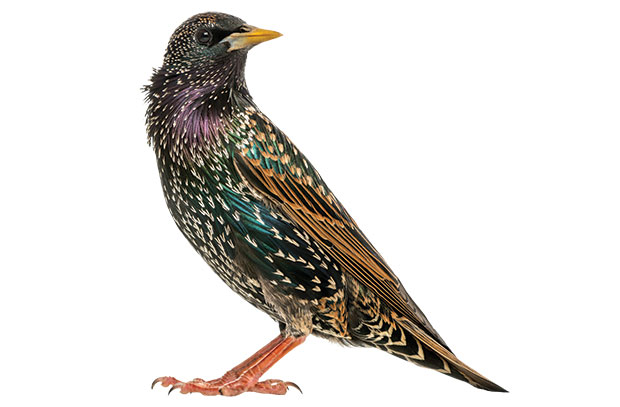
J & L Pest Control is a family owed business that has been practicing Integrated Pest Management (IPM) services since it was founded.
T (631)-605-9919
Email: jandlpestcontrol@gmail.com
J & L Pest Control
1090 Martinstien Ave.
Bay Shore, NY 11706

INTRODUCTION. Starlings were introduced from Europe into New York City in the 1890's. They are nuisance pests in both urban and rural areas and gather in large roosting flocks. Their noise and droppings are objectionable, and they can cause economic grain and feed loss. Starlings are of medical concern because more than 25 diseases and ectoparasites have been associated with starlings, their nests, and droppings. They are found in southern Alaska, the southern half of Canada, throughout the United States, and into northern Mexico.
RECOGNITION. Adults about 7 1/2-8 1/2" (19-22 cm) long; average weight about 2 1/2¬3 oz (70-85 g). Stocky and short-tailed. Color seasonal, in spring and summer black with iridescent green-purple sheen and bill yellow; in winter heavily speckled with white and gold and bill dark. Each of 2 legs short, bearing 1 rear-projecting and 3 forward-projecting toes. Body and wings covered with feathers and horny bill moderately long, lacking teeth. Voice a simple low-pitched, chirpy chatter interspersed with whistles, clicks, and mimicked songs and calls. Fledged young greyish brown above and lighter below; look like different species.
BIOLOGY. Mating occurs in the spring. Females usually lay 4-6 eggs (range 2-8) per clutch which are white, pale bluish, or greenish white, and some may have dark spots. Eggs require 11-14 days of incubation which is done by both sexes. Both parents help feed the young. First flight takes place at 19-22 days and young leave the nest shortly thereafter. There are usually 2 broods per season.
Starlings, their nests, and droppings are of medical concern because of the over 25 diseases and ectoparasites associated with them. Diseases include encephalitis (St. Louis, eastern and western equine), histoplasmosis, Newcastle disease, chlamydiosis, and salmonellosis which can affect human and animal health, and severe cases may result in death. The ectoparasites include primarily mite species which can bite humans or infest domestic animals, causing extreme discomfort. Other arthropods, such as dermestid beetles, clothes moths, and stored product pests, associated with the nests and droppings may invade structures.
HABITS. Starlings nest in tree cavities, birdhouses, and in almost any hole, nook, or crannie in and around a structure. They often displace native hole-nesting birds, such as woodpeckers, bluebirds, flickers, etc. The nest consists of grasses, twigs, straw, and debris. Nests are often reused and become foul because no sanitation is practiced.In the spring, flocks may be separated into parents and unpaired first brood. During the summer, parents and first brood birds merge into larger flocks. By autumn, flocks may number in the hundreds to the thousands. They cause serious problems when such massive flocks come into urban areas or cities to roost. Part of these flocks migrate several hundred miles south for the winter. Others remain in the same area year round and usually roost in protected areas, such as in urban buildings or dense pine stands, during the winter. At dawn, starlings fly in flocks as far as 70 mi (113 km) from their roosting site to a feeding site. When they return to their roosting site around dusk, they first perch on nearby utility lines, trees, buildings, etc. until after sunset. Then they fly around the roost before settling in for the night.
Starlings feed on the ground and at some distance from their roosting sites. During the breeding season (spring and summer) their diet is chiefly insects and other invertebrates and sometimes berries, fruits, and seeds. During the late summer, their diet shifts to primarily grains, seeds, and fruits. Livestock feed makes up a large portion of their winter diet. Each bird may consume up to 1 oz (28 g) of grain per day. If desperate, they will feed on almost anything. When roosting, starlings fly as a flock at the first sign of anything unusual, such as a j sudden noise or lights. However, they are quick to adjust to city sounds and lights.Starlings not only consume large quantities of animal feed, but foul much of that not eaten and can spread livestock diseases, such as hog cholera. They can also cause considerable damage in orchards and on small fruit and vegetable farms.
CONTROL. Many options are available for bird control. There are 3 methods that do not utilize toxicants. The first is exclusion which involves structural modification (e.g. change ledge angle to 45°), the installation of plastic netting on portions of buildings (denies access to perching and/or roosting sites), and/or the use of repellents such as plastic and metal spines, monofilament and steel lines, and gels and pastes. Second is sanitation which involves the reduction or elimination of feeding sites and temporary water sources. The third involves the use of sound devices such as noise-making devices and distress calls (usually not suitable for urban areas).
Please call us today for a free no obligation quote for the removal and exclusion of these birds.
